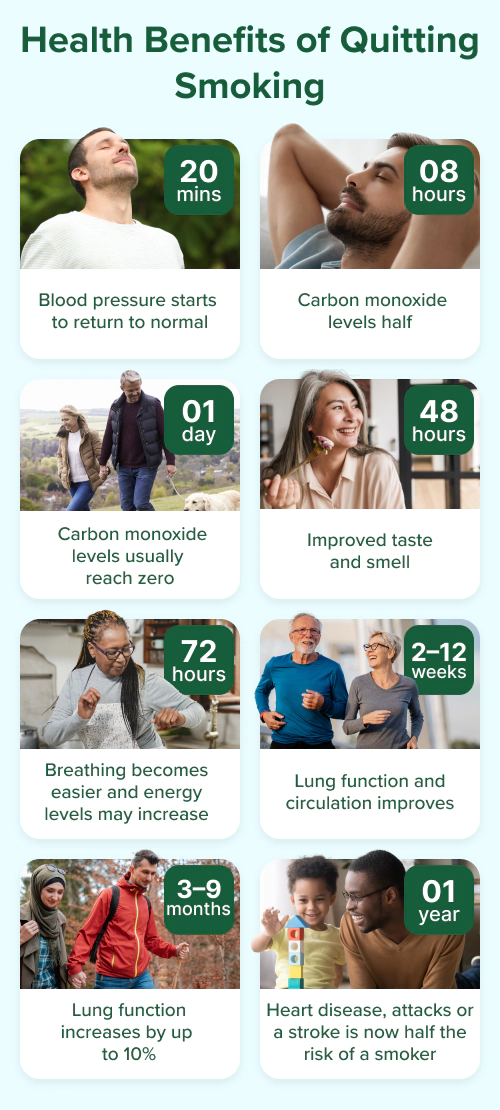How long does it take to stop smoking?
A quit smoking timeline can help you know what to expect when you stop. And it can be a great way to stay motivated on your journey to enjoying the health benefits of a smoke-free future. Quitting smoking can be a challenge, so reminding yourself of the reasons why you want to stop may help – especially the positive effect it can have on your health. The journey to quit smoking can also have a number of personal and social benefits, including protecting the health of your family and friends and reduced stress. There are also a number of visible benefits to quitting smoking including smoother skin, better oral health and fitness.
A stop smoking timeline can help you visualise each step on your journey and the positive changes you’re making along the way. For instance, did you know that the health benefits can kick in just 20 minutes after your last cigarette? Discover all the great ways you can improve your health through giving up – putting you on the path to a brighter tomorrow.
And remember, it’s never too late to put away the cigarettes for good. However long you’ve been a smoker and whatever your age, the benefits can begin quickly – as our stop smoking timeline explains. Get inspired by the success stories of people who quit smoking.

Stop Smoking Timeline - Enjoy fast benefits from Quitting
20 minutes after quitting smoking
In just 20 minutes, your blood pressure and pulse (heart rate) should start to return to their normal levels
8 hours after quitting smoking
8 hours in and the harmful carbon monoxide levels in your blood should have now halved. This can also see your oxygen levels recover and start to return to their normal levels.
1 day after quitting smoking
You made it to the end of a full day without smoking! All traces of carbon monoxide have usually left the body and your lungs start to clear.
48 hours after quitting smoking
Day 2 of no smoking and your taste and sense of smell should be improving.
72 hours after quitting smoking
Reach day 3 with no smoking and you should find breathing easier as your bronchial tubes start to relax. As breathing becomes easier you may also find your energy levels are starting to increase.
2 to 12 weeks after quitting smoking
From 2 weeks after quitting smoking and over the coming months, you may notice that exercise and other physical activity is easier. This is because, at this stage, your lung function increases and your circulation improves, with blood flowing through to your muscles and heart much better. Your immune system should receive a boost too, so your body can fight off colds and flu better. Finally, you may feel up to putting up that shed, painting the hallway or anything else on your to-do list!
3 to 9 months after quitting smoking
The breathing problems and wheezing you might have experienced when you were smoking should now be improving. That’s because around this point your lung function increases by up to 10%.
The air sacs in your lungs – known as cilia – should have regrown, healing some of the damage caused by smoking. Smoking related tiredness should now have disappeared.
1 year after quitting smoking
You’ve made it to a year without smoking! Take some time to give yourself a well-earned pat on the back. A year in and your risk of heart disease, attacks or a stroke is now half that of a smoker. Hopefully you feel much healthier – and wealthier, given what you’ve saved by not buying cigarettes for 12 months.
Begin your journey to a smoke-free future with Nicorette
The Nicorette range of Nicotine Replacement Therapy (NRT) products are clinically proven to help you quit smoking . They aim to help you quit for good by providing a low level of nicotine to help reduce unpleasant withdrawal effects that may occur when you quit smoking.
Find the right product for you – choose from mouth sprays , patches , gum , inhalators and lozenges and start your own quit smoking timeline today.




